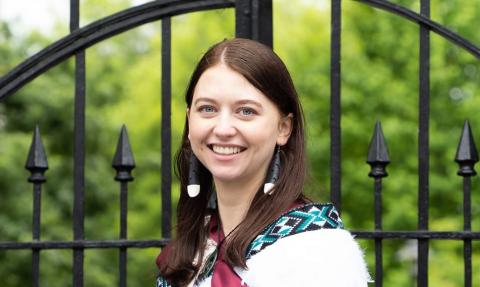
Dr Alice Eruera (Ngāpuhi) had a tragic introduction to the invisible world of the microbiome when she was a child. Alice’s grandfather was admitted to Auckland Hospital with broken bones sustained from a workplace injury. A self-confessed ‘koro’s girl’, Alice was left bereft when, after only a few days of his hospital stay, her cherished koro died from a superbug infection. His untimely death was to be a pivotal moment for Alice’s future.
As a teenager, Alice became absorbed with learning about the world of tiny organisms and at age 16, remembers reading a book from the library about parasites. “I was always interested in these kinds of diseases and when I read about other people dying for no good reason, like my koro, the idea of becoming a microbiologist started taking hold,” she says.
“My koro died for no good reason in a hospital that was supposed to be taking care of him. Our people die, are more likely to die, for pointless reasons and that has driven me to learn more about this specialty,” she says.
Now a biophysicist at the University of Otago Microbiology Department, Alice is proudly the first person from her whānau to ever attend university and is the first ever Division of Health Science Māori Postdoctoral fellow. Today, Alice works as part of a leading team of scientists who are using cutting-edge techniques to learn more about how the microbiome affects the health of humans, the environment, other animals in our ecosystem, as well as other organisms in the invisible world.
Alice’s mahi is centred on researching the shape of viruses. Because viruses are smaller than light particles, they cannot be perceived by a normal microscope. So, Alice uses a cryo-electron microscope to perceive the viruses. She then photographs them millions of times from every angle, and from those images, Alice creates 3D models to establish their shape.
She explains that the shape of a virus controls how they behave. “Every little detail about its shape controls whether it can infect you, whether it can infect your dog, what type of cell it can replicate in – everything about the function of a virus is controlled by its shape.”
Once this is understood, scientists can then begin to work on strategies to mitigate their functioning if they are deemed a risk. Knowing the shape of a virus enables drugs to be designed that bind over the top of the shape so that it is unable to access cells, or scientists can design antibodies that block these specific areas, she says.
Alice is working on several projects using this technology and some involve researching the structure of native viruses. One project she is currently working on is attempting to combat a virus infecting the Hoiho (Yellow-Eyed Penguin). Eighty percent of Hoiho chicks die from a virus passed on from their mother, and the team at Otago is trying to understand how this virus behaves using Alice’s 3D modelling.
Another project is researching a hepatitis virus that infects native tuna (eels). Alice says working on such projects gives her a sense of her own mana motuhake. “There are a lot more viruses that can potentially challenge our taonga and we have a responsibility to our taonga to take care of them, which is why I am passionate about my work. While I am passionate about human diseases, I am just as passionate about our taonga. I see it as our responsibility to look after our taiao, and work on things that Māori care about for Māori,” says Alice.
While some viruses are not helpful to human health, other viruses can be helpful, explains Alice. “Ecology is like an intricate net of connections and whanaungatanga between all of these organisms - the relationships between them and how they treat each other - create the net that allows life to flourish. Too much of one organism can be balanced by another organism, maintaining the balance,” she says.
Another exciting area is the burgeoning science of phage therapy and how microorganisms can attack each other. The team at Otago is currently undertaking research on the Seneca Valley virus which has the ability to destroy tumour cells, while leaving healthy cells intact. Using such microorganisms to combat disease has implications for treating cancer as well as superbug infections.
“We are finding new viruses all the time which is why I’m so excited about this work. If my koro had access to phage therapy and it had been properly developed, they could have given him a dose of a perfectly safe phage virus and he may not have died.”
Alice says international collaborations are one of the most inspirational things she sees in science today, and the networks she is creating are one of the most enjoyable aspects of her work. Alice recently returned from presenting a workshop and seminar about 3D atomic modelling at Sun Yat-sen University in Guangzhou City, China.
“I love all the chances I have been given to work with international teams because they approach the same problem differently from you. If you just hang out in your own little academic circle, you all end up thinking the same. But if you work with people from different backgrounds and cultures, you open your mind to thinking about different ways to tackle the same issue.”
“It is very thrilling to be at the edge of what we know and to push that edge further and further out. It makes me want to get up every morning and go to work.”